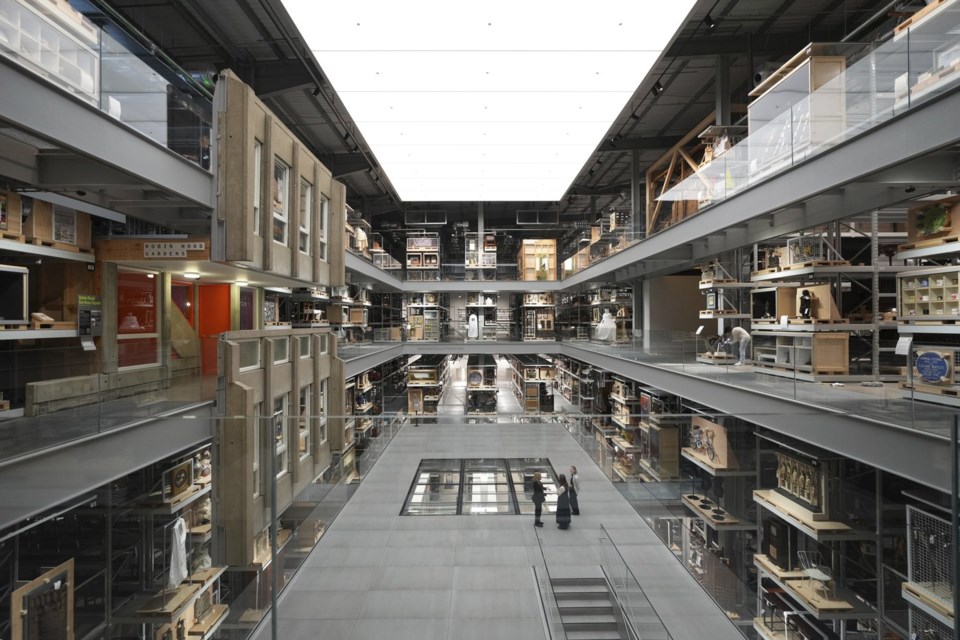LONDON (AP) ā A museum is like an iceberg. Most of it is out of sight.
Most big collections have only a fraction of their items on display, with the rest locked away in storage. But not at the new V&A East Storehouse, where Londonās has opened up its storerooms for visitors to view ā and in many cases touch ā the items within.
The 16,000-square-meter (170,000-square-foot) building, bigger than 30 basketball courts, holds more than 250,000 objects, 350,000 books and 1,000 archives. Wandering its huge, three-story collections hall feels like a trip to IKEA, but with treasures at every turn.
The V&A is Britainās national museum of design, performance and applied arts, and the storehouse holds aisle after aisle of open shelves lined with everything from ancient Egyptian shoes to Roman pottery, ancient Indian sculptures, Japanese armor, Modernist furniture, a Piaggio scooter and a brightly painted garbage can from the Glastonbury Festival.
āItās 5,000 years of creativity,ā said Kate Parsons, the museumās director of collection care and access. It took more than a year, and 379 truckloads, to move the objects from the museumās former storage facility in west London to the new site.
Get up close to objects
In the museumās biggest innovation, anyone can book a one-on-one appointment with any object, from a Vivienne Westwood mohair sweater to a tiny Japanese netsuke figurine. Most of the items can even be handled, with exceptions for hazardous materials, such as Victorian wallpaper that contains arsenic.
The Order an Object service offers āa behind-the-scenes, very personal, close interactionā with the collection, Parsons said as she showed off one of the most requested items so far: a 1954 pink silk taffeta Balenciaga evening gown. Nearby in one of the study rooms were a Bob Mackie-designed military tunic worn by on his 1981 world tour and two silk kimonos laid out ready for a visit.
Parsons said there has been āa phenomenal responseā from the public since the building opened at the end of May. Visitors have ranged from people seeking inspiration for their weddings to art students and āsomeone last week who was using equipment to measure the thread count of an 1850 dress.ā She says strangers who have come to view different objects often strike up conversations.
āItās just wonderful,ā Parsons said. āYou never quite know. ā¦ We have this entirely new concept and of course we hope and we believe and we do audience research and we think that people are going to come. But until they actually did, and came through the doors, we didnāt know.ā
A new cultural district
The V&Aās flagship museum in Londonās affluent South Kensington district, founded in the 1850s, is one of Britainās biggest tourist attractions. The Storehouse is across town in the Olympic Park, a post-industrial swath of east London that hosted the 2012 summer games.
As part of post-Olympic regeneration, the area is now home to a new cultural quarter that includes arts and fashion colleges, a dance theater and another V&A branch, due to open next year. The Storehouse has hired dozens of young people recruited from the surrounding area, which includes some of Londonās most deprived districts.
Designed by Diller, Scofidio and Renfro, the firm behind New Yorkās High Line park, the building has space to show off objects too big to have been displayed very often before, including a 17th-century Mughal colonnade from India, a 1930s modernist office designed by Frank Lloyd Wright and a Pablo Picasso-designed stage curtain for a 1924 ballet, some 10 meters (more than 30 feet) high.
Also on a monumental scale are large chunks of vanished buildings, including a gilded 15th-century ceiling from the Torrijos Palace in Spain and a slab of the concrete faƧade of Robin Hood Gardens, a demolished London housing estate.
Not a hushed temple of art, this is a working facility. Conversation is encouraged and forklifts beep in the background. Workers are finishing the , a home for the late London-born musicianās archive of costumes, musical instruments, letters, lyrics and photos that is due to open at the Storehouse in September.
Museums seek transparency
One aim of the Storehouse is to expose the museumās inner workings, through displays delving into all aspects of the conservatorsā job ā from the eternal battle against insects to the numbering system for museum contents ā and a viewing gallery to watch staff at work.
The increased openness comes as museums in the U.K. are under increasing scrutiny over the origins of their collections. They face pressure to return objects acquired in sometimes contested circumstances during the days of the British Empire
Senior curator Georgia Haseldine said the V&A is adopting a policy of transparency, āso that we can talk very openly about where things have come from, how they ended up in the V&Aās collection, and also make sure that researchers, as well as local people and people visiting from all around the world, have free and equitable access to these objects.
āOn average, museums have one to five percent of their collections on show,ā she said. āWhat weāre doing here is saying, āNo, this whole collection belongs to all of us. This is a national collection and you should have access to it.ā That is our fundamental principle.ā
Jill Lawless, The Associated Press



